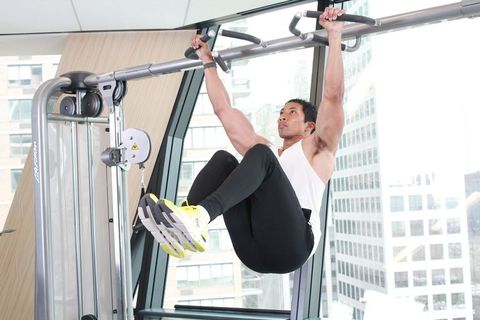For lots of guys, the range of moves included in their personal catalogue of “ab workouts” includes a very limited scope of exercises. They think that core training is only done in a corner away from the rest of their workout, a small area where they get down on the ground to plank, crunch, and lift their legs up to carve their six-packs in earnest. That’s not the only way to build up your abs, according to Men’s Health fitness director Ebenezer Samuel, C.S.C.S. Get up off the ground and try the hanging leg raise to challenge your core and shake up your standard routine.
But there’s a right way to go about the exercise—and there’s definitely a wrong way, too. “You’ve seen variations of this exercise before,” Samuel says. “You’ve seen CrossFitters doing toes to bar, you’ve seen other people doing hanging L-Sits.” The hanging leg raise, however, allows you to focus on the contraction of your abs, rather than just lifting your lower half up into the air.
To learn how to nail the movement to keep your focus directly on your core, watch how Samuel and Men’s Health fitness editor Brett Williams, NASM demonstrate all of the subtleties of the exercise. From hanging properly to the performing the actual raise, there’s more to know than just grip, hang, and lift. Make sure that you have a sturdy pullup bar handy and plenty of room for the raise, then get ready to work.

How to Do the Hanging Leg Raise

Get a Grip
Starting the exercise by getting the setup right is essential. If your bar setup is too high for you to grab from where you stand beneath it, use a step to get your hands on. “It is not worth jumping up to the bar and trying to find your grip because you are not going to be able to create the proper tension,” Samuel advises.
Once your hands are in place, make sure your palms are on top of the bar. If you’re hanging from your fingers, you might be setting yourself up for failure—the hang becomes more of a challenge for your grip strength, than a position from which you’re going to work your abs. “We don’t want to be in a position where we’re losing our grip and where our grip is the mitigating factor so that we can’t really train our core.”
No Dead Hang
Once your hands are locked in place, your focus should shift to the hang—it’s in the move’s name, after all. For this, you won’t get the most out of the exercise if your whole body isn’t engaged. Instead of a dead hang, Samuel wants you to squeeze your shoulder blades so that you can keep yourself in a position to succeed; in other words, a position where you don’t create momentum from swinging.
From there, pull your ribcage in, and make sure that you’re creating full-body tension so that your legs are slightly in front of your torso.
Raise, Then Show Your Butt
There are multiple ways that people do this exercise, as Samuel stated—but if you’re going to hit the form he wants from you, you’re going to have to show your butt. Instead of stopping at an L position of shooting your feet all the way up to the bar, bend you knees slightly, then curl your legs up.
When it comes time to lift, that’s when your butt comes into play. Raise up, and your rear end should be on full display to anyone standing in front of the bar. “That ensures that we’re not just moving at our hips, but our abs are driving the motion,” says Samuel. “That’s because our abs are creating all this spinal flexion and all of this rounding—we’re creating that and we’re managing that as we’re doing the motion.
Want to master even more moves? Check out our entire Form Check series.
Source: Read Full Article
